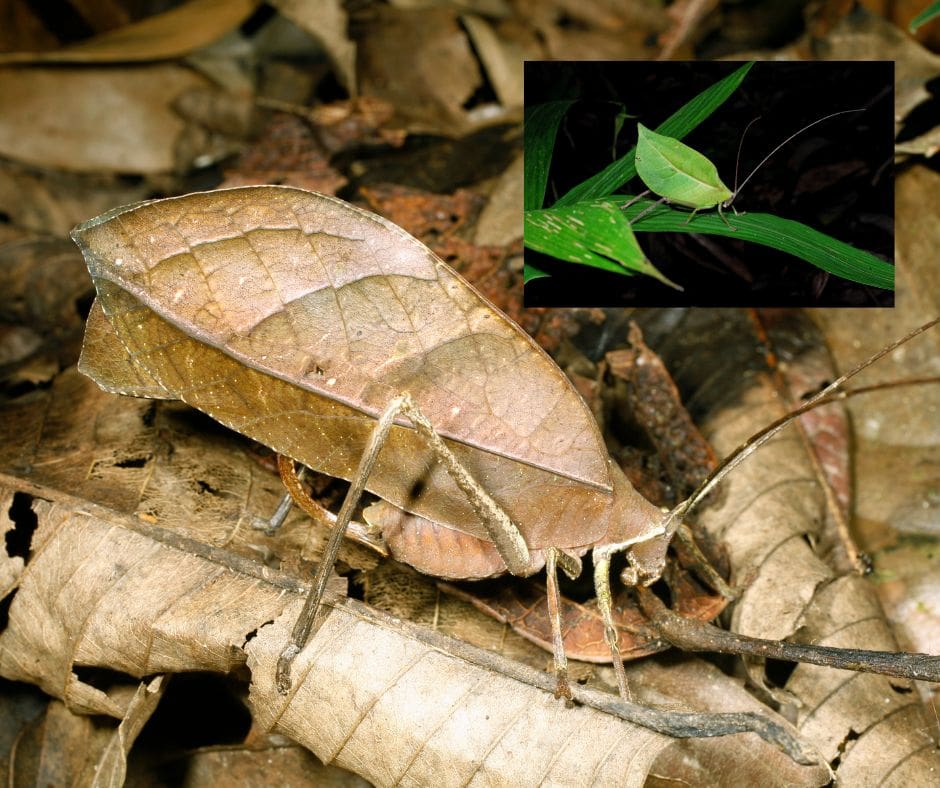In the heart of Costa Rica’s lush rainforests, a master of disguise plays an intricate game of hide and seek. This elusive artist is none other than the leaf-mimic katydid, a true marvel of nature’s camouflage. Blending seamlessly with its verdant surroundings, the katydid is a testament to the extraordinary adaptations of wildlife in the rainforest.
Masters of Disguise
The leaf-mimic katydid, as its name suggests, has perfected the art of imitation. These insects are so adept at mimicking leaves that they can be nearly impossible to spot. With wings that resemble the texture and color of leaves, complete with veins and edges that mirror those of real foliage, the katydid can easily go unnoticed by both predators and humans.
The intricacies of their camouflage are astonishing. The katydid’s body can imitate various stages of leaf life, from fresh green to decaying brown, complete with spots, holes, and even signs of fungal infection. This remarkable ability not only helps them evade predators but also allows them to ambush prey effectively.
Where to Spot These Elusive Creatures
For those eager to catch a glimpse of these natural illusionists, Costa Rica offers several prime locations. The dense rainforests of Corcovado National Park, located on the Osa Peninsula, provide an ideal habitat. Here, among the towering trees and dense underbrush, leaf-mimic katydids find ample opportunities to blend in.
Another excellent location is the Monteverde Cloud Forest Reserve. This mist-shrouded sanctuary is home to a myriad of flora and fauna, making it a hotspot for biodiversity. The leaf-mimic katydid thrives in such environments, where the abundance of leaves provides endless camouflage opportunities.
Manuel Antonio National Park, known for its stunning coastal views and rich wildlife, also offers a chance to encounter these fascinating insects. The park’s combination of rainforest and beach creates a unique ecosystem where leaf-mimic katydids can be found hiding in plain sight.
Contribution to the Ecosystem
The leaf-mimic katydid plays a crucial role in maintaining the balance of the rainforest ecosystem. As both predator and prey, they are integral to the food web. Their primary diet consists of leaves, flowers, and smaller insects. By feeding on plant material, they help control vegetation growth, which in turn affects the distribution and abundance of other species.
Moreover, katydids serve as a vital food source for a variety of predators, including birds, bats, and reptiles. Their population dynamics can significantly influence the abundance of these predators. In this intricate web of life, the leaf-mimic katydid’s presence ensures the continued health and diversity of the rainforest ecosystem.
The Art of Survival
The survival of the leaf-mimic katydid hinges on its ability to remain unseen. This exceptional camouflage is not just a means of evading predators but also a strategy for avoiding detection by potential mates and competitors. During the mating season, male katydids produce distinctive calls to attract females. These calls, while aiding in reproduction, can also give away their location to predators. Thus, the art of remaining inconspicuous becomes even more critical.
Additionally, katydids exhibit fascinating behaviors to enhance their camouflage. They often sway back and forth, mimicking the motion of leaves in the breeze. This subtle movement can deceive even the most discerning predators, ensuring the katydid’s safety.
The Marvel of Adaptation
The leaf-mimic katydid is a prime example of nature’s ingenuity. Their extraordinary camouflage is a result of millions of years of evolution, fine-tuning their appearance to match their surroundings perfectly. This adaptation is not just a survival mechanism but a work of art, showcasing the beauty and complexity of life in the rainforest.
Exploring the rainforests of Costa Rica, one cannot help but marvel at the diversity of life that thrives in these environments. The leaf-mimic katydid, with its remarkable mimicry and vital ecological role, stands out as a symbol of the intricate balance that sustains the rainforest.






